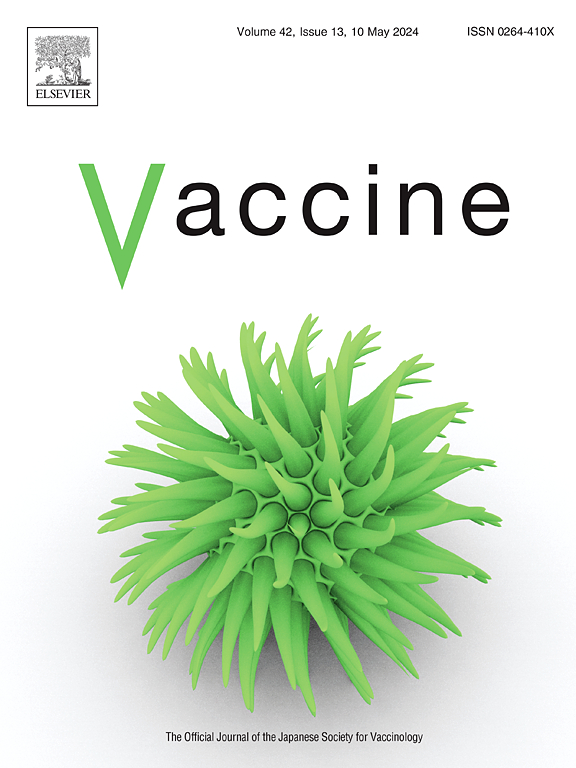Impact of 10-year measles, mumps and rubella booster vaccination program among healthcare personnel: a cross-sectional study
IF 4.5
3区 医学
Q2 IMMUNOLOGY
引用次数: 0
Abstract
Introduction
The study aimed to assess the effects of a single-dose measles, mumps, and rubella (MMR) booster vaccination, without prior testing, on MMR immunity and infection among vulnerable healthcare personnel (HCP) 10 years after implementation in a highly vaccinated population.
Methods
We conducted a single-center, cross-sectional study to assess the MMR seroprevalence in HCP and health examinees enrolled from December 2021 through April 2023. Since 2013, the hospital has provided a single-dose MMR booster vaccine to HCP working in high-risk units and those born in or after 1981 (≤41 years of age). HCP who met the Taiwan CDC's operational criteria for measles immunity were exempted. MMR-specific IgG antibodies were measured, and detailed vaccination histories were obtained.
Results
A total of 732 participants were enrolled, including 528 HCP and 204 health examinees. The median age was 43 years, and 74.6 % were female. The overall seroprevalence rates of measles, mumps, and rubella were 89.8 %, 91.0 % and 88.0 %, respectively. The measles seroprevalence rate was lowest among participants aged 31–40 years (80.4 % in HCP and 82.4 % in health examinees). In multivariable analysis, age was associated with measles seropositivity (per 1-year increase, aOR, 1.08; 95 % CI 1.04–1.12). Receiving MMR booster vaccination in adulthood was associated with seropositivity for measles (aOR, 2.77; 95 % CI, 1.46–5.24) and mumps (aOR, 2.39; 95 % CI, 1.23–4.65). No cases of measles acquisition or intra-hospital spread were identified among HCP during the past 10 years.
Conclusions
An MMR booster vaccination program is feasible and effective in maintaining high seropositivity rates for MMR, particularly among HCP at risk of waning immunity.
10年麻疹、腮腺炎和风疹加强疫苗接种计划对医护人员的影响:一项横断面研究
本研究旨在评估未事先检测的单剂量麻疹、腮腺炎和风疹(MMR)加强疫苗接种在高度接种人群中实施10年后对弱势卫生保健人员(HCP)中MMR免疫和感染的影响。方法:我们进行了一项单中心横断面研究,评估2021年12月至2023年4月入组的HCP和健康体检者中MMR的血清患病率。自2013年起,医院为高危单位工作人员和1981年及以后出生(≤41岁)的HCP患者提供单剂MMR加强疫苗。符合台湾疾控中心麻疹免疫操作标准的HCP可获豁免。测量mmr特异性IgG抗体,并获得详细的疫苗接种史。结果共纳入受试者732人,其中HCP 528人,体检者204人。中位年龄为43岁,74.6%为女性。麻疹、腮腺炎和风疹的总血清阳性率分别为89.8%、91.0%和88.0%。31-40岁人群麻疹血清患病率最低(HCP为80.4%,体检者为82.4%)。在多变量分析中,年龄与麻疹血清阳性相关(每1年增加,aOR, 1.08; 95% CI 1.04-1.12)。成年期接受MMR强化疫苗接种与麻疹(aOR, 2.77; 95% CI, 1.46-5.24)和腮腺炎(aOR, 2.39; 95% CI, 1.23-4.65)的血清阳性相关。在过去10年中,没有发现HCP感染病例或医院内传播病例。结论MMR加强疫苗接种计划对维持高MMR血清阳性率是可行和有效的,特别是在有免疫力下降风险的HCP人群中。
本文章由计算机程序翻译,如有差异,请以英文原文为准。
求助全文
约1分钟内获得全文
求助全文
来源期刊

Vaccine
医学-免疫学
CiteScore
8.70
自引率
5.50%
发文量
992
审稿时长
131 days
期刊介绍:
Vaccine is unique in publishing the highest quality science across all disciplines relevant to the field of vaccinology - all original article submissions across basic and clinical research, vaccine manufacturing, history, public policy, behavioral science and ethics, social sciences, safety, and many other related areas are welcomed. The submission categories as given in the Guide for Authors indicate where we receive the most papers. Papers outside these major areas are also welcome and authors are encouraged to contact us with specific questions.
 求助内容:
求助内容: 应助结果提醒方式:
应助结果提醒方式:


